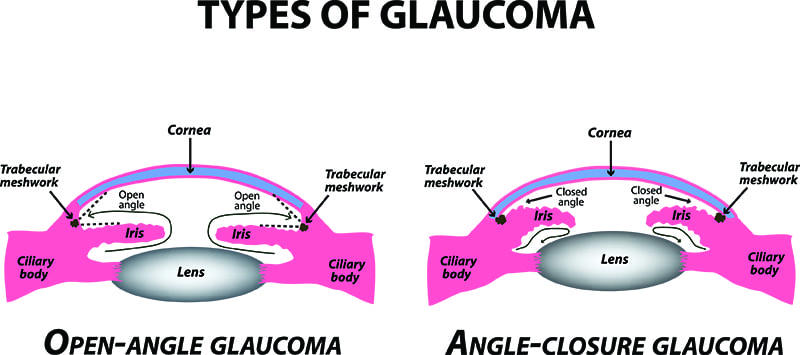Glaucoma
Glaucoma is one of the leading causes of blindness in the United States. It can often go undetected until irreversible damage has been done to one’s eyesight, so it is crucial to schedule regular eye exams, where this disease can be detected early on through routine screening. At Prestera Eye, Dr. Tory Prestera and Dr. Howard Guan offer specialized treatment options that can preserve your vision and prevent further damage.
- What Is Glaucoma?
- Glaucoma Symptoms & Causes
- Ocular Hypertension
- Open Angle Glaucoma
- Narrow Angle Glaucoma
- Glaucoma Risk Factors
- Glaucoma Treatments
- Glaucoma Cost
- Additional Glaucoma FAQs
What Is Glaucoma?
Glaucoma refers to gradual vision loss caused by optic nerve damage due to increased pressure in the eye. This can occur when there is a buildup of aqueous fluid in the eye due to overproduction of fluid and/or a lack of proper drainage. Unfortunately, there is no cure for glaucoma or any way to reverse existing damage, so it is important for this disease to be diagnosed as soon as possible.
What Are the Causes and Symptoms of Glaucoma?
In the earliest stages of glaucoma, patients typically experience no pain, and do not have a noticeable loss of vision. Once symptoms of glaucoma have become apparent, significant damage has likely already been done. This is why it is sometimes referred to as the “silent thief of sight.”
Glaucoma’s effects cannot be reversed, but getting proper treatment from an experienced eye doctor can help prevent the disease from progressing. Depending on the type of glaucoma present, some symptoms may include loss of peripheral vision, blurry vision, halos, a feeling of intense pain and pressure in the eye, nausea, and light sensitivity.
What Is Ocular Hypertension?
 Ocular hypertension is a condition in which the eye’s pressure is elevated, but no discernable damage has yet occurred to the optic nerve. This may also be referred to as “pre-glaucoma” or “glaucoma suspect,” since the increased pressure caused by ocular hypertension can potentially lead to the development of glaucoma. If ocular hypertension is detected, Dr. Prestera and Dr. Guan may recommend treatment to help reduce the pressure in your eyes and ultimately prevent the onset of glaucoma.
Ocular hypertension is a condition in which the eye’s pressure is elevated, but no discernable damage has yet occurred to the optic nerve. This may also be referred to as “pre-glaucoma” or “glaucoma suspect,” since the increased pressure caused by ocular hypertension can potentially lead to the development of glaucoma. If ocular hypertension is detected, Dr. Prestera and Dr. Guan may recommend treatment to help reduce the pressure in your eyes and ultimately prevent the onset of glaucoma.
What Is Open Angle Glaucoma?
Open angle glaucoma is the most common form of glaucoma. It progresses slowly, and is the result of the eye’s drainage system becoming blocked over time. When this happens, fluid begins to build up in the eye, eventually causing increased intraocular pressure and damage to the optic nerve. Since this type of glaucoma develops gradually, symptoms generally go unnoticed until serious damage has already occurred.

What Is Narrow Angle Glaucoma?
Narrow angle glaucoma is the second most common type of glaucoma. Patients with narrow angles are at risk of acute angle closure, which can rapidly lead to very high eye pressures that require immediate medical attention. Narrow angle glaucoma is indicated when the iris arches forward and blocks the eye’s drainage system either partially or completely, causing rapid fluid buildup. In acute cases, symptoms are typically painful and noticeable. There are more chronic forms of narrow angle glaucoma that may not produce symptoms.
Who Is at Risk for Glaucoma?
Most people who are affected by glaucoma are over 40, but it can affect individuals of any age. In addition, genetics are considered a main risk factor for glaucoma, but even patients with no family history of the disease may develop it. Those with high refractive errors are also at risk, and certain medications may cause increased pressure in the eye.
Dr. Prestera and Dr. Guan will perform thorough glaucoma evaluations for any patients with risk factors.
What Are My Treatment Options for Glaucoma?
To treat glaucoma, Dr. Prestera and Dr. Guan offer medicated eye drops, as well as laser therapy, Minimally Invasive Glaucoma Surgery (MIGS), and more. If you are diagnosed with glaucoma, your doctor will discuss initial treatment options (typically daily eye drops or laser) and help you decide which treatment option is better for you. The laser therapy is designed to be safe and comfortable (most patients experience little to no discomfort). It can improve fluid drainage in the eye with and without cutting or damaging any tissue in the eye. Patients who receive laser therapy can often reduce or eliminate the need for medicated eye drops. Additionally, the doctors may perform Minimally Invasive Glaucoma Surgery (MIGS), often at the same time as cataract surgery, to improve eye pressure or even eliminate the need to use eye drops.
Below is more information about glaucoma treatment options available at Prestera Eye:
- Selective Laser Trabeculoplasty – SLT is a laser procedure designed to help lower eye pressure by increasing the amount of fluid that’s drained from within the eye. The laser has minimal heat energy absorption and the procedure often produces less scar tissue than other options.
- DURYSTA® – DURYSTA® is an FDA-approved, dissolvable ocular implant that gradually medicates the eye to reduce excessive pressure. The treatment can be especially beneficial for patients with open angle glaucoma and ocular hypertension (high eye pressure) who are unable to use eye drops regularly.
- Minimally Invasive Glaucoma Surgery – Also referred to as MIGS, Minimally Invasive Glaucoma Surgery is a group of procedures that utilize small incisions to help improve the drainage of eye fluids. MIGS is often considered a safe and effective option for reducing eye pressure, with quicker recovery time than most other treatments.
- Tube Shunts – A glaucoma tube shunt is an advanced surgery that involves small tubes implanted into the eye to help drain excess fluid. The procedure is designed to help improve vision and decrease eye pressure, and may be more helpful for those struggling with neovascular glaucoma.
- Trabeculectomy – Another more advanced option is a trabeculectomy. This surgery creates a new pathway for eye fluid to drain and help prevent further vision loss.
How Much Does Glaucoma Treatment Cost?
The cost of your glaucoma treatment will typically depend on the severity of your condition, the necessary medications, the extent of work done in procedures, and more. Following a comprehensive eye exam, our team can provide you with a customized estimate based on your specific needs. We are committed to transparent pricing and will help you understand all potential costs. Additionally, we are happy to speak with your insurance if need be, and are proud to offer a variety of financing options to facilitate payment.
Additional Glaucoma Frequently Asked Questions
How often should I be screened for glaucoma?
The frequency of glaucoma screening depends on your age, risk factors, and overall eye health. In general, adults over 40 should have a thorough eye exam every two to four years, while those over 60—or individuals with risk factors such as a family history of glaucoma, diabetes, or African or Hispanic ancestry—should be screened every one to two years. If you have elevated eye pressure or early signs of glaucoma, we may recommend more frequent monitoring. Early detection is essential to preserving your vision, so it is important to follow guidelines for regular exams. If you have concerns about your glaucoma risk, please talk with our team to develop a personalized screening plan.
Can I prevent glaucoma from developing?
While there is no guaranteed way to prevent glaucoma, there are steps you can take to protect your eye health. Routine eye exams are crucial, as early detection allows for timely treatment to slow the progression of the disease. Maintaining a healthy lifestyle that includes consistent exercise, managing conditions such as diabetes and high blood pressure, and avoiding smoking, may also help reduce your risk. Protecting your eyes from injury and following the recommendations of our eye care team are equally important. If you have a family history of glaucoma or other risk factors, be proactive about monitoring your eye health and discuss a individualized prevention plan with us.
How does glaucoma differ from cataracts?
Glaucoma and cataracts are both eye conditions that can affect vision, but they differ in their causes and treatments. Glaucoma occurs when the optic nerve is damaged, usually due to increased pressure within the eye. It often develops gradually and can lead to permanent vision loss if not treated.
Cataracts, on the other hand, occur when the eye’s natural lens becomes cloudy, typically as a result of aging. This condition can cause blurry or dim vision but does not damage the optic nerve and is usually correctable with surgery to replace the cloudy lens. Unlike cataract-related vision changes, glaucoma-related vision loss cannot be reversed, though treatment can slow its progression. Since these conditions affect different parts of the eye, regular eye exams are essential for early diagnosis and effective management to help preserve healthy vision.
Contact Prestera Eye Medical Group
To schedule a comprehensive eye exam that includes screening for glaucoma, please contact us today.